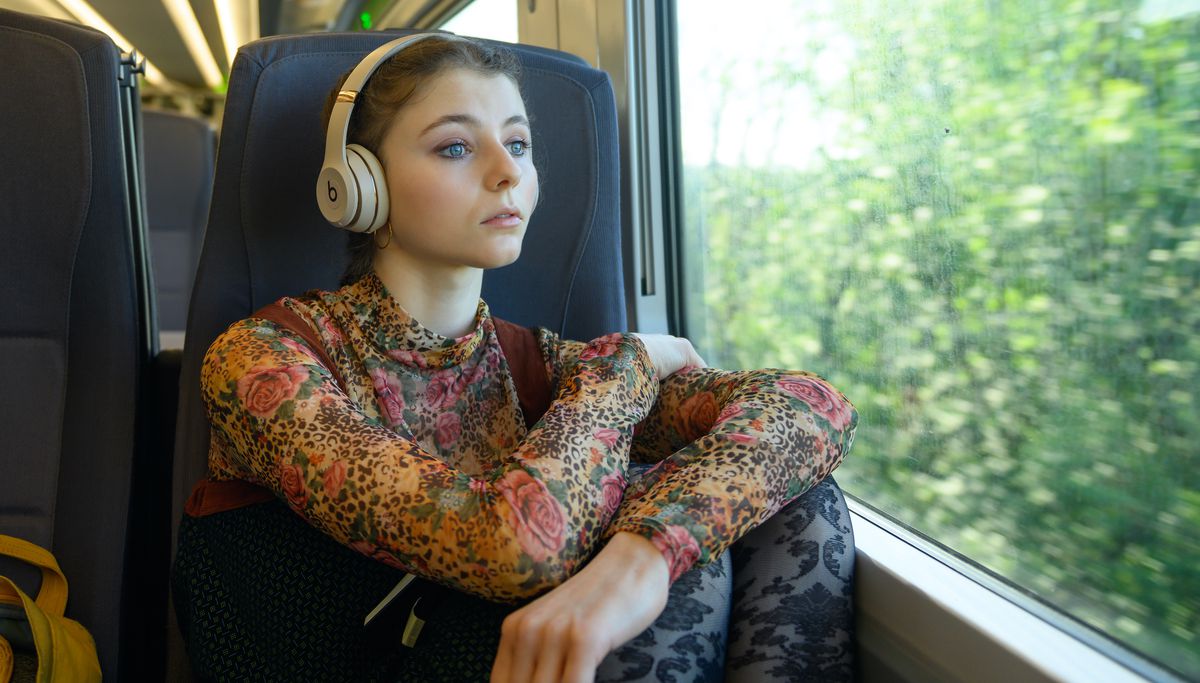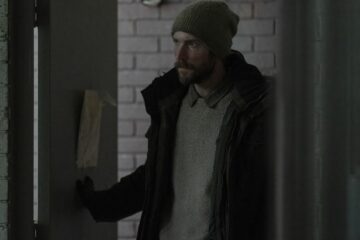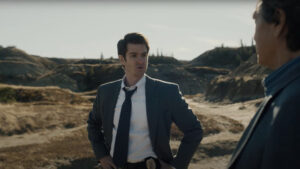Edgar Wright is an artist perennially wedded to vibes, but that’s seldom meant a loss of substance. And in Last Night in Soho, a Wright film partially set in the Swinging Sixties, the vibes are myriad. There’s the karaoke score, with contemporaneous bangers from Sandie Shaw, Dusty Springfield, The Kinks, and John Barry. There’s costume designer Odile Dicks-Mireaux’s stunning haute couture, her white PVC macs and bubblegum-pink ballgowns evoking the best of Sixties style, pulled from the heroines of Mario Bava and Michelangelo Antonioni. And Wright himself brings his encyclopedic film knowledge to the table, as has become his directorial signature, with a smorgasbord of ’60s cinematic reference points.
The most grizzled Wright apologists among us know he’s been doing this kind of thing since the TV series Spaced, one of the greatest satires of the ’90s. But 2004’s Shaun of the Dead gave his stylistic sensibilities an international platform. It isn’t just a heartfelt, gloriously crafted rom-com in the Richard Curtis vein of Notting Hill and Four Weddings. It’s a cinematic introduction to Wright’s bombastic style on the silver screen. Think: his frantic, hotly paced editing, cutting together half-second whip-pans and smash zooms; fast-paced montages, often rhythmically synced to a karaoke score; overtly stylized genre evocation. This over-the-top tone bleeds into Wright’s sense of humor, for instance when Ed (Nick Frost) shouts Night of the Living Dead’s famous line “We’re coming to get you, Barbara!” in an attempt to reassure his best friend’s mother.
Few contemporary directors are so metonymic in their cultivated styles. As with Martin Scorsese, Quentin Tarantino, or, gulp, Michael Bay, when you hear “Edgar Wright,” you tend to know what you’re in for. Last Night in Soho hardly diverges from the expected Wrightian norm. It’s a feast for the cineaste senses, chock full of reference points from giallo maven Dario Argento to the syrup-blood-soaked Hammer Horror flicks of the 1960s. Nearly every shot is awash with neon blues and deep reds. Soho is a colorful fantasy that knowingly cuts from the nostalgic cloth of classic horror.

Here, Wright is as visually indebted to Argento’s Suspiria as he is to Roman Polanski’s Repulsion, though the latter may go some way in explaining some of the film’s deeper flaws around the presentation of gendered violence. The film’s gender makeup is novel for Wright, who’s never previously centered a film on female characters. But this story converges on two of them: Precocious, shy fashion-school student Ellie (Thomasin McKenzie) in the present, and bold would-be dance-hall star Sandie (Anya Taylor-Joy) in the 1960s.
The first act contains some of Wright’s finest work, and the opening sequence is a marvel. Ellie dances around her home in an elaborate ballgown made of newspaper to Peter and Gordon’s “A World Without Love,” in a scene that speaks to Ellie’s profound nostalgia, her poverty, and her creativity all at the same time. It’s also a reminder of Wright’s affinity for needle-drops. Even before reality distorts, this is a young woman deeply invested in the past: not in an obnoxious, “born in the wrong decade” way, but demonstrative of trauma so potent that distant eras become an escapist salve.
Ellie quickly leaves her sheltered rural British town to begin the long journey to London, a record player and a suitcase of vinyls in tow. London is downright mythic for a dewy-eyed kid like Ellie: the big smoke breathes with centuries worth of dreams. Aspirationalism is one of Last Night in Soho’s implicit themes, particularly the desire to make a mark on the world, and leave a legacy behind. Where better, then, to place Ellie’s story than the concrete time capsule of London, where myriad hopes have been realized, and legacies are etched into the city’s rebar bones and marble plinths?
Heading to her residence hall, Ellie gets her first lesson in London from a leering taxi driver. “Are you a model?” he asks, practically salivating. For the first time, she sees the insidious imperfections in her fantasy, from perverse cabbies to bully-ish peers. The latter group revolves around Ellie’s deeply insecure roommate Jocasta (Synnove Karlsen), an amalgamation of every The Devil Wears Prada trope under the sun. Wright loves a snappy line-read, and his scripts are always laden with clever quips. Karlsen is given the film’s best: “I tried vaping,” she says, preparing a cigarette, “but it makes you look like a cunt.”
When Ellie leaves the dorm to stay in a bedsit on Goodge Street (leaving aside the realities of a poor kid with a bursary being able to afford the neighborhood’s extortionate rent) Wright’s stylistic flair-ometer shoots to 110. Hopping into bed, lulled into sleep by her vinyls, Ellie is drawn into the past, emerging in Leicester Square. A grandiose Thunderball marquee suggests it’s 1965 — notably, the year of Repulsion.

The opening strings of Cilla Black’s “You’re My World” sound eerily similar to the famous Psycho score: better fit for a horror film, perhaps, than a romantic pop ballad. Wright’s passion for needle-drops emerges again, as Ellie hears this song as she enters the past. The heady, lovelorn charm of Black’s lyrics eerily juxtapose against the jarring shrillness of the song’s opening notes. And, as it turns out, Black herself is performing the song within the scene, for an adoring crowd of tuxes and frocks. The images are dream-like, a product of Ellie’s deepest nostalgic fantasies — and seemingly Wright’s as well.
That’s just one example of how Wright’s penchant for pop music comes through in Soho. The soundtrack is the catchiest and vibiest, of his filmography — even more so than Baby Driver, which is wall-to-wall bops. On the one hand, he uses iconic ’60s tracks to emphasize the film’s fantasy: As that opening scene establishes, one of the reasons Ellie is so wedded to the past is her adoration of the music.
And it also places the audience in the era. As with Baby Driver, some of the songs are crucially, knowingly on-the-nose: Soon after Soho takes a more explicitly supernatural turn, for example, R. Dean Taylor’s “There’s a Ghost in My House” is cued. It’s enjoyably catchy, but more than thematically pertinent. And as the use of Carla Thomas’ “B-A-B-Y” refers to the eponymous protagonist in Driver, a scene in Soho’s final act sees Ellie serenaded with a rendition of Barry Ryan’s emphatic foot-tapper “Eloise.”
Some of the later numbers, as Soho switches tonally into something altogether darker, carry terrible irony. When Sandie is pushed to feature in a lewd stage performance, made up like a marionette doll, she dances suggestively to Sandie Shaw’s campy, cabaret-style tune “Puppet on a String.” (Speaking to its campiness, it was the UK’s first Eurovision winner, in 1967.) In another Wrightian subversion, the silliness of the song becomes tragedy, as Sandie’s attempts at stardom head in a dark direction.
Using such an iconic song to underpin her emotional turmoil is a deft directorial choice that also points to Soho’s most compelling conceit. Wright’s career has been marked by, and wedded to, an adoration of the cultural past. But here, he fights the urge, with the message that nostalgia is just a pair of rose-tinted goggles, obscuring darker realities hidden beneath the glitzy surface.

There’s a lot to balance in Soho, though, and Wright isn’t always successful. His previous films are far from vacuous, but they’re comparatively inconsequential. There’s the zombie comedy, the buddy cop/murder mystery, the Body Snatchers homage, the superhero pastiche, and the heist flick. (Which might be his crowning achievement, save for the unfortunate-in-retrospect casting of alleged sex offenders Kevin Spacey and Jamie Foxx.) Wright may have wanted to do something meaningful with his first woman protagonist, but Soho is dealing with far weightier themes than any of its predecessors: abject sexual violence, psychopathy, suicide and depression, memory and trauma.
While he maintains his stylistic pomp and flourish — that aesthetic deftness his fans expect — the characters, plot, and said hefty themes, are thin on the page in the final act. Ellie is drained of agency, her erratic mental state increasingly evocative of Carol’s in Repulsion. She embodies the histrionics that typified the women of classic giallo horror, in a jarring example of Wright’s affinity for homage. A motif where she sees her dead mother in mirrors isn’t fully realized, which inadvertently serves to trivialize her mental trauma.
In one Hammer-esque scene, Wright’s overt stylization explodes into a kaleidoscopic mushroom cloud of showy genre evocation. A victim’s eyes are seen in reflection in the blade of a raised knife, and strawberry sauce gets thrown around the place as the weapon repeatedly descends. While Soho remains a feast for the senses until the very end, framing ongoing sexual violence in such an exploitative fashion risks superficiality, even when he’s consciously evoking giallo, particularly Mario Bava’s Blood and Black Lace.
Centrally, as a study of Wright’s own nostalgic proclivities, Soho is a fascinating cultural object. He’s demonstrated an interest in the frailty of nostalgia in previous works. In Hot Fuzz and The World’s End, characters are beholden to, and castigated for, unrealistic nostalgia. Stylistically, though, he’s always leaned into homage, again going as far back as Spaced, with its myriad visual and textual references to Hollywood and more esoteric cinema. Homage in itself is adjacent to nostalgia: It’s the celebration, in Wright’s case, of past styles and aesthetics, and deep, wistful love for decades-old cinema percolates through his filmography.
Soho feels like Wright’s most explicit interrogation of his own sentimental impulses, and simultaneously, his most stylistically grandiose work. But central to this story, too, is the violent and lurid exploitation of women. This is certainly Edgar Wright at his Edgar Wright-iest, but even as he’s arguing against celebrating the past in Last Night in Soho, he’s celebrating it himself, in ways that are hard to escape, and at times, harder still to enjoy.
Last Night in Soho opens in theaters Oct. 29.
Source: https://www.polygon.com/reviews/22752939/last-night-in-soho-review-edgar-wright
- 110
- aesthetic
- All
- among
- around
- artist
- audience
- Bay
- BEST
- Black
- Blade
- British
- Career
- case
- cinema
- Cloud
- Comedy
- coming
- creativity
- dead
- dealing
- depression
- designer
- dreams
- driver
- Elaborate
- Enters
- FANTASY
- fascinating
- Fashion
- Feature
- fights
- Film
- films
- First
- first time
- fit
- flaws
- Focus
- full
- Gender
- Ghost
- Group
- head
- hears
- here
- Hollywood
- Home
- How
- HTTPS
- Humor
- interest
- International
- IT
- knowledge
- Line
- London
- Long
- love
- makeup
- mark
- Marvel
- May
- model
- mother
- Music
- Neon
- numbers
- performance
- platform
- player
- Pomp
- poor
- Poverty
- present
- Product
- protagonist
- realities
- Reality
- reasons
- record
- Rent
- Rural
- Screen
- sees
- sense
- Series
- set
- Sex
- Silver
- sleep
- So
- square
- Stage
- State
- stay
- strawberry
- street
- Student
- Study
- substance
- successful
- Suicide
- superhero
- supernatural
- Surface
- The
- the world
- time
- tv
- us
- What
- within
- woman
- Women
- Work
- works
- world
- worth
- year
- youtube












